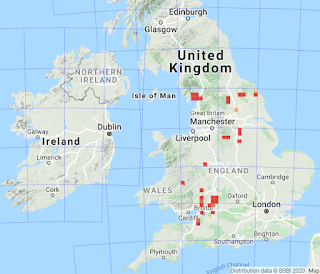 |
| Fingered sedge near Lynne's home Image: L. Farrell |
At the time of writing, botanising away from the home, whilst
sticking to the rules, is permitted in England. BSBI
President Lynne Farrell is fortunate to have some first-rate habitat right
on her doorstep and within walking distance, so she did some careful planning
and then ventured out.
Over to Lynne:
“I live in the Arnside and Silverdale AONB,
which straddles both West Lancashire
(VC60) and Westmorland (VC69), and
recently, I’ve walked some of the local footpaths close to my home, keeping my
distance from other local people, who have also been exploring these pathways.
Once the Government guidance on permitted daily exercise was updated last week,
I took the opportunity to look up the local Rare Plant Register and the
records on the BSBI Distribution
Database for the rare Fingered
Sedge Carex digitata, which, I was aware, has one of its main areas right
on my doorstep.
 |
| BSBI distribution map for Fingered Sedge Dark red squares show C21st records Pale pink squares show C20th records |
"Plotting the sites on the local 2.5 inch OS map, it became
clear that I could actually walk to many of them from my home, and so during
this exceptionally fine spell of weather, I have investigated what was, to me,
a relatively unfamiliar species.
“Now I am aware that Carex digitata prefers to be in dappled
shade, on well-drained limestone, often rocky banks and even though it has not
rained here for more than a month, it has flowered well, although in some of
the more open limestone pavements places it is looking rather desiccated.
"Clearly this is a plant which takes its opportunity to grow, flower and fruit
before the leaves are fully expanded on the trees, often Yew Taxus baccata, Ash
Fraxinus excelsior and Hazel Corylus avellana. Other grounds flora plants have
often not emerged but Dog’s Mercury Mercuralis perennis is a frequent
associate.
 |
| The woodland where Lynne saw Fingered Sedge: click on the image and zoom in to see the plants Image: L. Farrell |
“There are only another 286 species listed in the Cumbria
Rare Plant Register and Fly Orchid Ophrys insectifera is the next target
species I’ll be looking at, as it struggles to come into flower in this dry May,
and I am now allowed to walk a little further afield to investigate. I’ll let
you all know how I get on”.
Many thanks to Lynne for telling us about the Fingered Sedge
which she is lucky enough to have so close to her home.
We’re always keen to hear which plants people are spotting
while sticking to those essential guidelines about staying safe. So, whether
you are exploring rare plants or common species, whether within walking distance,
right on your doorstep or in
your garden, why not drop us a line and let us know what you are spotting?
But please remember to read the
guidelines carefully before planning any journeys outside your home and do
take all the necessary precautions - the plants will still be there next year
and we want you to be there too so you can enjoy them!
No comments:
Post a Comment
Please leave a comment!